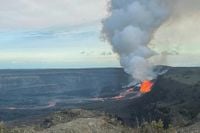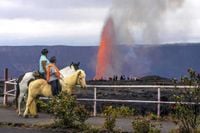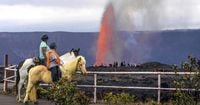At Hawaii Volcanoes National Park, anticipation and awe mingle in the air as the Kilauea volcano once again claims the world’s attention. As of August 19, 2025, scientists have confirmed that Kilauea is erupting from two vents, sending molten lava shooting a staggering 600 feet into the sky, according to the US Geological Survey. The night sky above Hawaii Island glows with the fiery spectacle, drawing crowds both in person and online, eager to witness nature’s raw power in real time.
This latest eruption marks the 31st episode since December 2024, a remarkable frequency that has volcanologists and park officials on high alert. The current activity is part of a series of repeated lava fountain episodes, a phenomenon that has only occurred four times in the last two centuries, as reported by the Associated Press. Scientists have been closely monitoring magma flow from a lower chamber beneath the volcano, which is driving the ongoing eruption. Their vigilant observation and advanced monitoring technologies have allowed them to predict these eruptions a few days in advance—an invaluable asset for public safety and scientific understanding.
"Scientists talk about the Kilauea volcano at the Hawaii Volcanoes National Park as the volcano continues to send out smoke, steam and lava," the Associated Press noted, capturing the tense but controlled atmosphere at the park. The eruption, while dramatic, is not entirely unexpected. Kilauea has long been one of the world’s most active volcanoes, with its frequent eruptions shaping not just the landscape but also the culture and traditions of Hawaii.
For many Native Hawaiians, the Halemaumau Crater—the source of the current eruption—holds profound spiritual significance. It is revered as the sacred home of Pele, the volcano goddess, whose presence is felt in every plume of smoke and every river of lava. In Hawaiian tradition, these eruptions are not merely destructive events but essential processes that create new land and renew the earth. Lava is seen as a natural resource, a living force that continuously reshapes the island, adding new layers to its storied history.
The eruption has also transformed the park’s atmosphere, drawing a surge of visitors eager to witness the spectacle. According to the National Park Service, visitation has significantly increased since the eruption began. The influx of tourists brings both excitement and challenges. Park officials are urging all visitors to remain on marked trails and heed safety warnings, as volcanic hazards—including toxic gases, unstable ground, and sudden lava flows—remain ever-present dangers. "Visitors are advised to stay on marked trails and be aware of volcanic hazards," the National Park Service emphasized in a recent statement.
For those unable to travel to Hawaii, the US Geological Survey has stepped in with a modern solution: livestreams of the eruption. Hundreds of thousands of viewers are tuning in from around the globe, captivated by the real-time images of lava fountains and glowing flows. The livestreams provide not just a window into the unfolding event, but also a valuable educational tool, helping the public understand both the beauty and the risks of volcanic activity. The USGS’s efforts to make these natural wonders accessible underscore the blending of ancient tradition and cutting-edge technology that defines the modern response to volcanic eruptions.
Behind the scenes, scientists are working tirelessly to monitor the volcano’s every move. Using a sophisticated network of sensors, cameras, and satellite data, they track the flow of magma from Kilauea’s lower chamber, analyze seismic activity, and assess the potential for further eruptions. The ability to predict eruptions a few days in advance is a testament to decades of research and collaboration among geologists, seismologists, and local officials. This predictive capacity not only enhances public safety, allowing for timely warnings and evacuations if necessary, but also deepens our understanding of the dynamic processes shaping our planet.
The repeated lava fountain episodes observed at Kilauea are of particular interest to scientists. According to the USGS, this is only the fourth time in 200 years that such a pattern has been recorded. Each episode provides new data and insights into the inner workings of the volcano, helping researchers refine their models and improve future forecasts. The ongoing eruption offers a unique opportunity to study volcanic behavior in real time, with implications for both local communities and the broader scientific community.
Yet the eruption’s impact extends far beyond the boundaries of science. For local residents, the event is a reminder of both the power and the unpredictability of the natural world. Some see the eruption as a cause for celebration—a visible sign of the island’s vitality and resilience. Others approach it with caution, mindful of the potential risks to homes, infrastructure, and health. The tension between reverence and respect, between curiosity and caution, is palpable throughout the region.
Economic considerations are also at play. The surge in park visitation has brought a welcome boost to local businesses, from tour operators to restaurants and hotels. However, officials are careful to balance economic opportunity with the need to protect both visitors and the environment. Strict safety protocols are in place, and rangers are on hand to provide guidance and ensure compliance with park regulations. The challenge is to allow people to experience the wonder of Kilauea while minimizing the risks associated with volcanic activity.
As the eruption continues, attention is also turning to the long-term implications for Hawaii’s landscape and ecology. The formation of new land, while dramatic, can have complex effects on local ecosystems. Native plants and animals must adapt to the changing terrain, and scientists are closely monitoring these impacts. At the same time, the creation of new land is a powerful symbol of renewal—a tangible reminder that life on the islands is shaped by cycles of destruction and creation.
For many, the eruption is a moment of reflection as well as spectacle. It prompts questions about our relationship with nature, our ability to predict and respond to natural disasters, and the ways in which tradition and science can work together to deepen our understanding of the world. As scientists, park officials, and local communities navigate the challenges and opportunities presented by Kilauea’s latest eruption, one thing is clear: the volcano’s story is far from over, and its lessons will resonate for generations to come.
With lava still lighting up the night sky and scientists keeping a careful watch, Hawaii’s Kilauea volcano remains both a source of wonder and a reminder of nature’s enduring power.


